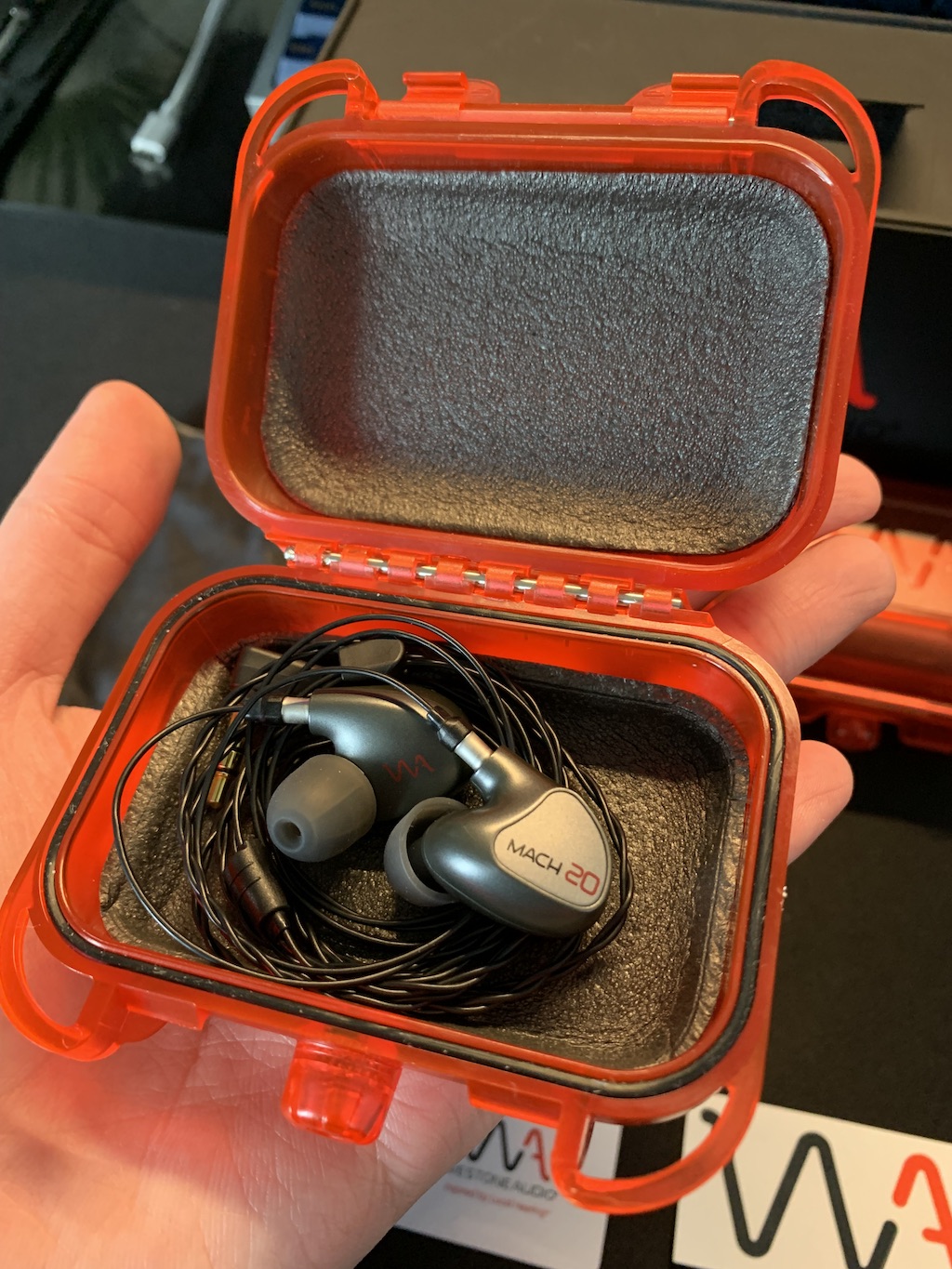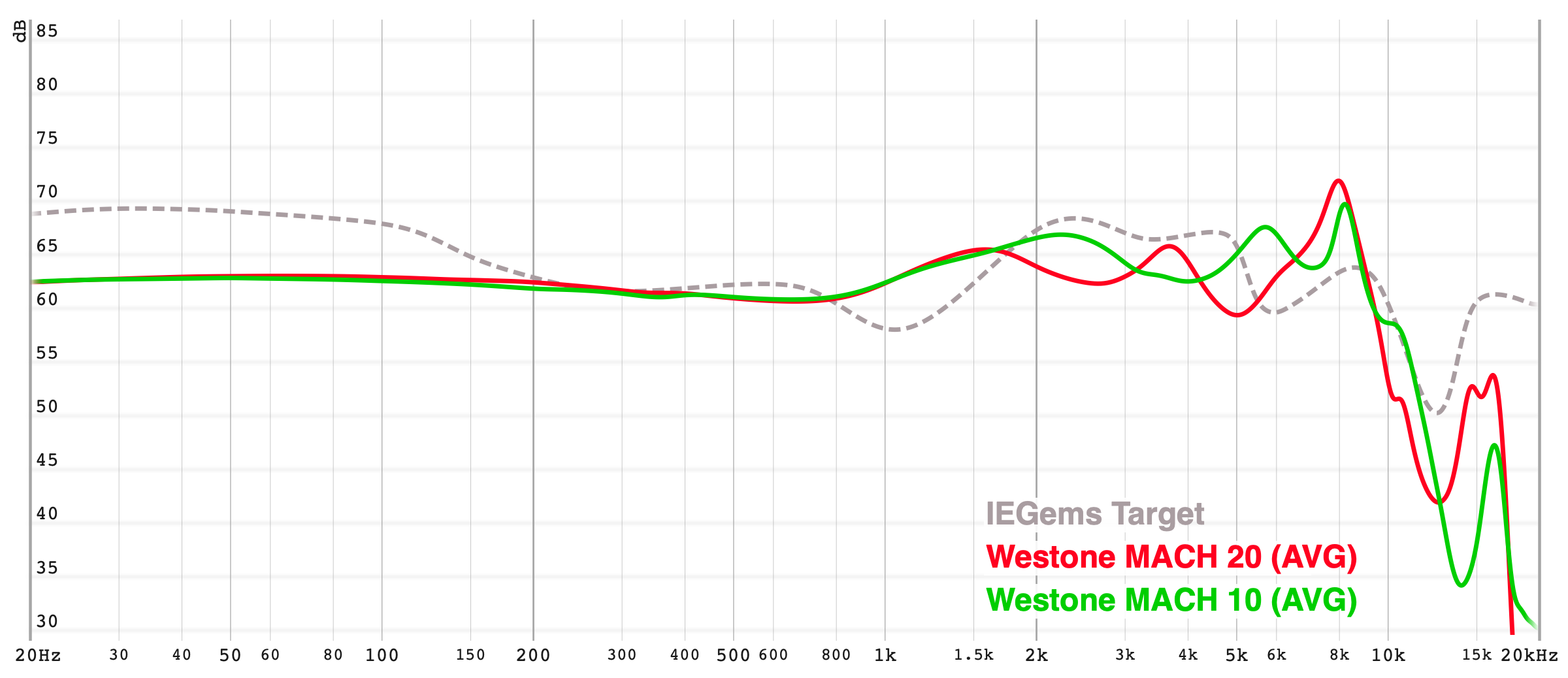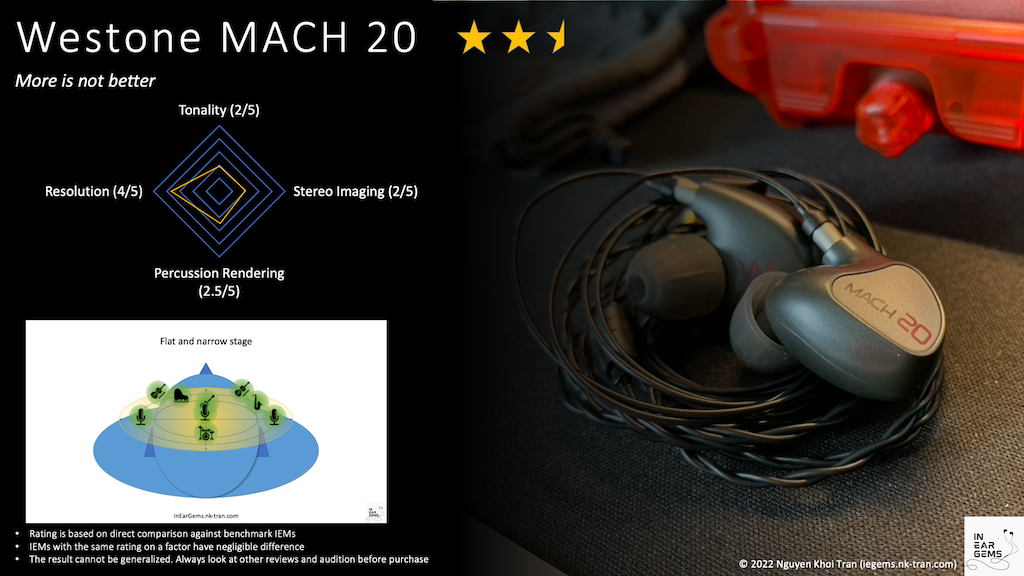Westone MACH 20 - More is not better
Is more better?
It depends. More IEMs? Of course! More drivers in an IEM? Not always.
So, would MACH 20 be better than MACH 10 by having one extra BA driver? Let’s find out.
Forewords
- This review is based on a loaned unit from Westone via the MACH launch tour. It has been delivered to the next reviewer in the tour. Thank you @Zachik for coordination.
- I believe that great IEMs are the ones that can achieve multiple difficult things simultaneously: (1) high resolution (meaning lines of music are crisp, clear, easy to follow and full of texture), (2) 3D soundstage with a strong sense of depth, (3) bold and natural bass with physical rumble, (4) natural timbre, (5) relaxing and comfortable tonality. IEMs achieving those criteria are rated highly in my ranking list
- I rate IEMs by A/B tests them against a few benchmark IEMs, regardless of price point. If a $1000 IEM scores the same as a $100 IEM, then either the more expensive one underperforms or the budget one is a gem. See the methodology for more detail..
- I use frequency response measurements to double check my subjective impressions.
- Rating database and measurement database can be found on my IEM review blog.
Non-sound Aspects

MACH 20 is exactly the same as MACH 10 from the outside, so I would direct you to my previous review on MACH 10 rather than copying everything here.
tl;dr: very stable and comfortable fit, highly isolating, generous accessories, annoying cable.
 Noted that MACH 20 is not as difficult to drive at MACH 10 even though it one more driver. You can use whatever clean audio source that you have, including apple dongle.
Noted that MACH 20 is not as difficult to drive at MACH 10 even though it one more driver. You can use whatever clean audio source that you have, including apple dongle.
How it sounds
 Frequency response of MACH 20 against MACH 10 and my preference target (bassy with tuning tricks for soundstage). Measurements were done with an IEC-711 compliant coupler and might only be compared with other measurements from this same coupler. The resonance peak was aligned at around 8kHz. Such a peak might be larger on the graph than in real life. Measurements above the resonance peak might not be accurate. Visit my graph database for more comparisons.
Frequency response of MACH 20 against MACH 10 and my preference target (bassy with tuning tricks for soundstage). Measurements were done with an IEC-711 compliant coupler and might only be compared with other measurements from this same coupler. The resonance peak was aligned at around 8kHz. Such a peak might be larger on the graph than in real life. Measurements above the resonance peak might not be accurate. Visit my graph database for more comparisons.
Tonality and Timbre: 3/5 - Average
Test tracks:
- Bon Jovi - Livin’ On A Prayer Drum cover ( Tarn Softwhip ): testing tonal balance. Is there too much kick drum? Is there too little kick drum? Is there enough stick impact on the snare? Are the cymbals and high hats correct sounding? How about the toms? How about vocal?
- Delibes: Lakmé - Duo des fleurs (Flower Duet), Sabine Devieilhe & Marianne Crebassa: how natural are the vocals?
- J.S. Bach: Goldberg Variations, BWV 988 - Variatio 15 Canone alla Quinta. a 1 Clav. Andante: how natural is the piano? How is the balance between various voices in the canon? Can you hear the subtle variation in dynamic (loudness) from soft to very soft throughout the variation?
- MS Gundam Build Fighters (OST): do you hear any metallic tint in the high pitched electronic instrument at the opening? Is there any harshness? Unusual tonality? This piece should be energetic but not harsh.
Warm but kind of odd.
MACH 20 has a warm tonality due to having lower contrast between lower midrange and upper midrange. This tonality is achieved by lowering the upper midrange and lower-treble region (ear gain) rather than boosting the lower frequencies. In fact, measurement shows that MACH 20 matches MACH 10 exactly until around 1.5kHz.
The warmer tuning of MACH 20 lends vocals and instruments a rich and relaxing tone. You would not feel uncomfortable or strained when singers reach a high note or when a high-pitched instrument is played. Sibilance is non-existent, unless the original music is already sibilant. Despite the warmth, MACH 20 avoids making the midrange too “stuffy” or muddy. In fact, vocals are reproduced with great details, down to subtle breaths.
However, the tonality of MACH 20 is not perfect. Far from it, actually. Firstly, MACH 20 is slightly nasally and honky. Most of the time and especially with warmer vocals, the IEM sounds more or less natural. However, the tonality quickly becomes uncanny with some higher-pitched vocals like Ed Sheeran’s. My impression was “huh, that does not sound right” when I checked the tonality with Bad Habits. A quick glance at the graph reveals the culprit: ear gain peaking at 1.5kHz, the honk region. I have yet to hear an IEM that sounds natural and has a normal soundstage with this kind of ear gain.
Secondly, MACH 20 lacks energy in the lower treble region (around 3kHz to 6kHz). Now, if you know me, you know that I am a big fan of dipping this region slightly to avoid shoutiness and diffuse the center image to simulate loud speakers. However, MACH 20 dips this area too much that instruments and vocals sound like they cannot reach high notes properly. This problem is similar to IEMs in the Campfire Audio Solaris series.
In overall, MACH 20 is more or less pleasant, but its faults are jarring whenever the music trigger them. Therefore, I rate MACH 20 3/5 in terms of tonality - average in the grand scheme.
Resolution, Detail, Separation: 4/5 - Good
Resolution, detail retrieval, or “technical performance” denotes how finely and crisp an IEM or headphone can reproduce audio information. Resolution manifests itself in various aspects: (1) how clear and precise the attack of musical notes are, (2) how pinpoint musical notes are in the soundstage, (3) how detailed and nuanced the decay and reverb of musical notes are, (4) how clear can you hear background elements of a mix and (5) can you hear the whole band or orchestra. A balanced tuning might help but is not a necessity for an IEM to achieve high resolution.
Test tracks:
- Sky Mubs - Now You believe in You: testing the detail of the background elements and the treble extension / air. How clear can you follow the choral section in the background before 0:50? How crisp and texture are the claps?
- Ed Sheeran: Tiny Desk (Home) Concert: visiting hours (from 14:20) is a good test for detail retrieval. How clear and distinct can you hear the chimes at the beginning? Can you hear individual chime or just a blob of high-pitched sound? How clear can you hear the backing vocal at the far sides of the soundstage?
- Vivaldi: Violin Concerto No. 2 in G Minor, RV 315 “L’estate” - III. Presto: testing resolution in complex and dense music. How easy it is to hear individual instruments? Can you hear nuances and textures in each instruments like bow catching on the strings? Can you hear the cello on the right? Can you feel the rumble of the lower strings of cello?
In overall, MACH 20 is a resolving IEM, more so than usual single-DD IEMs. However, it does not out-resolve the standard of “good” resolution Blessing 2. Note attacks on MACH 20 are noticeably blunter than on MACH 10, and despite having more lower-end energy, it does not reveal a richer and more textured stereo image than MACH 10 either.
Summer - Presto:
- Almost no difference from Blessing 2. Note attacks are a bit crisper on MACH 20, but micro details and texture at the tail-end of notes are more revealing on Blessing. Again, they are very close to each other in terms of performance.
- Not close to Andromeda level of performance.
Tiny Desk Performance (Visiting Hours):
- Again, almost no difference from Blessing 2 in both the clarity and precision of note attacks and the texture at the tail-end of the notes.
Rating: Blessing 2 (4/5 - Good) = MACH 20 (4/5 - Good) < Andromeda (5/5 - Outstanding)
Percussion Rendering: 2.5/5 - Below average
Percussion rendering reflects how well the tuning and technical performance of an IEM work together to recreate realistic sound of a drum set. Good drum hits have clear attack (controlled by frequencies from 4kHz to 6kHz), full body (midbass frequencies around 200Hz), and physical sensation (subbass frequencies around 50Hz). Good technical performance (“fast” driver) ensures that bass notes can be loud yet detailed. IEMs that cannot control bass very well tend to reduce the bass’ loudness to prevent muddiness.
Test tracks:
- Finale (William Tell Overture): How rhythmic the whole orchestra sound? Can you follow the drums clearly? How about the rhythm carried by the string and brass section? Can you hear texture and detail in the drum or just mushy thump thump sound?
- Bon Jovi - It’s My Life Drum Cover ( Tarn Softwhip ): How powerful is the kick drum? How clean are the stick impacts? Is there rumble and decay (“brrrm”)? How clear are the patterns played on the cymbals? Do the drums energise you?
- Proof of a Hero - Rise Version: This track tests only one thing: can the battle drums hype you up to pick up your longsword and chase some wyverns?
There is not much to talk about the percussion rendering of MACH 20. The stick impacts are fast and snappy as you would expect. Surprisingly, there is also a clear “thump” sound with kick drums. However, the body, the rumbling sensation, and texture of the bass is not there. You can hear enough bass to keep the rhythm, but there is not enough quantity and dynamic contrast to energise you.
Due to the reduction in loudness around the ear gain region, MACH 20 might feel a bit bassier than MACH 10 at the same listening volume. However, such quantity change does not translate to any real quality improvement.
Rating: ER2SE (2/5 - Lacking) < MACH 20 (2.5/5 - Below average) < Aria (3/5 - Average)
Stereo Imaging (Soundstage): 2/5 - Not good
Stereo imaging or “soundstage” is a psychoacoustic illusion that different elements of a recording appear at different locations inside and around your head. Your brain creates based on the cues such as the loudness and phase differences between left and right channel. Most IEMs do not differ significantly nor can compete with headphones or loudspeakers. However, some IEMs offer a more spacious soundstage than others. Best IEMs can create multiple layers sound from closer to further away and make some instrument floating slight above your head.
Test tracks:
- We are the world(3:00 onward): This song shows some excellent stereo imaging. Can you hear soloist upfront whilst the choir is pushed further away to the background? Can you hear one choir to the left and further to the back whilst the other to the right and a bit closer to you?
- Eine kleine Nachtmusik - I. Allegro: Listen for the clear direction of each instrument in the string quartet throughout the piece. You should also be able to hear cello locating closer to than the violin 1.
- I vow to thee, my country: This song is an excellent test for layering. Can you hear the boy choir standing in front of the men choir or they are on the same flat plane?
MACH 20 has an unapologetically in-the-head soundstage. The soundstage rarely extend beyond the head. Listening to MACH 20 feels like listening to a tiny concert hall in your head, not unlike MACH 10.
Now, smaller soundstage is not a deal breaker because a compact presentation can be desirable for more intimate genres such as singer-songwriter. The real problem lies in the way MACH 20 places the center image (main vocal and instrument) within the soundstage.
Most IEMs with proper ear gain generally place the center image in your head, just behind your eyes. Some IEMs with strategic dips around 1kHz and 3kHz can push the center image slightly in front of you.
MACH 20 is different. It tends to shove the center image right in your face. As a result, the shape of the soundstage is a bit distorted. This problem is very noticeable when you game: everything in front of you tend to sound incorrectly closer. I suspect this presentation has to do with the way MACH 20 peaks around 1.5 kHz, as I hear similar presentation in other IEMs with the same tuning style.
Rating: FH3 (2/5 - Not good) = MACH 20 (2/5 - Not good) < Aria (3/5 - Average)
Conclusion

The “IEM driver war” has shown us as that more is not always better. It is the case here with MACH 20 as well. Having one extra BA driver seems to reduce rather than improve the IEM’s performance across all criteria comparing to MACH 10. The tonality becomes more honky and unnatural. The soundstage becomes squashed and shallow. The resolution is slightly less impressive. The bass performance is still merely passable. The charm of MACH 10 is simply not there anymore.
I don’t quite get the design goal of MACH 20. If you are looking for a new universal IEM, I would recommend MACH 10 instead of MACH 20.
